WEDNESDAY'S SCRIPT TIP:
REALISTIC REACTIONS

A while back someone asked a question on a message board and my flip answer was "What Would Paul Schrader Do?" Even though Paul Schrader was one of the writers of THE LAST TEMPTATION OF CHRIST and was raised in a strict Calvinist family, I suspect he would have a different reaction than Jesus to a problem. His reaction would probably involve alienation, sudden violence, and the loss of fingers (I can name three Schrader films off the top of my head where fingers are removed in unpleasant ways). Everyone reacts differently to situations, and it's part of our job as writers to know *how* each character would react and to make sure that they *do* react. As Sir Isaac Newton once said, for every action there is an equal and opposite reaction. If your character doesn't react to a situation, you stop your story's momentum dead in its tracks.
The thing that will kill a script in a heartbeat is having your characters react in some strange way the audience can not identify with, or having them not react at all. I saw a screening of an unnamed horror movie (I know the writer-director) where a group of kids have car trouble in killer country and get picked off one-by-one. Early in the movie they are exploring one of those old dark houses where killers tend to live and one of the guys finds a few suspicious cars parked behind the house... and then finds the killer, who chops his head off. A couple of scenes later, the rest of the group are searching for the missing guy, and his *girlfriend* begins poking around the cars behind the house, opens the trunk of one car... and there is the decapitated body of the man she loves! What does she do? She calmly yells to the others that she has found him.
Now, this is not some scene where the victim's girlfriend goes into shock and is practically catatonic - that's a reaction that we understand. Instead, she acts as if seeing the headless body of the man she loves is an everyday event...
About the same level of emotional reaction as if she had found her lost car keys.
And when the others show up? They also take the head removal of their friend as a boring, every-day event. They have a calm discussion of what to do, and because this is one of those films, they decide to keep poking around the old dark house. Another reaction that makes absolutely no sense at all.
For the rest of the film, these close friends are killed one-by-one and never seem to react to any of it. It's as if they are just going through the story motions - nothing really matters to them.
If a guy I know gets his head chopped off and I open the trunk of the car and see his bloody body, I would probably puke. I can write scenes of violence, but I can't deal with them in real life. If *I* get hurt, I'm pretty calm... if someone else gets hurt, I'm a mess. When I saw this woman discover her boyfriend's bloody headless body and then react as if she's found her car keys, I stopped believing this character was real... and began to actually hate the film as every character had no human reaction at all to witnessing the deaths of their friends. Robots have more reactions... and more emotions. Without realistic reactions and realistic emotions, the film was dull. Did they really want a dull horror movie?
WHAT WOULD YOU DO?

So what would *you* do if you found the decapitated body of someone you love? That is probably the easiest way to get rid of strange reactions - put yourself in the character's shoes and imagine that this was happening to you. That's usually what writers do, anyway - we live a strange vicarious life through our characters. But often the fantasy life takes away the real reactions, and we don't want that. Look at every character in every scene and make sure they are reacting as if it is really happening to them... even though you made them up.
Every death in a silly horror movie like this is a great place for a character scene. Movies are about people with problems, and every scene exists to explore character - to show how these people react to their problems and deal with them. Character is exposed through conflict, and having some dude running around cutting off people's heads is a pretty good conflict. So the writer should have *used* the conflict to show character. How does each character react to the death of their friend? How is each reaction *different* and *character specific*? The writer should have made a list of different reactions to the death of a friend and then given each character a different reaction that shows us the character beneath the surface... and made it interesting!
Have the tough guy puke, then say he's okay as he wipes his mouth. Someone could say "That's not real, it's just a trick... someone playing a trick on us. It's not blood, it's nail polish." Someone could be unable to look. Someone could suddenly become take charge - *emotionless* and businesslike (but not the victim's girlfriend - that's not the right reaction for that relationship). Someone could become catatonic and has to be taken care of for the rest of the movie (that works for the victim's girlfriend). Someone could cry and be unable to stop. Someone could... you get the idea. The biggest problem I had with the movie was that none of these people seemed to care that their friends were getting brutally murder by a killer in a mask. You know, that doesn't happen every day.
Each reaction is a way to show what makes this character different.
Yes, some of this is the director's problem and the actor's problem - but if it ain't on the page it ain't on the stage. It all starts with our screenplays.
FALSE REACTIONS

The most annoying part of INDIANA JONES AND THE KINGDOM OF THE CRYSTAL SKULL are the character's reactions to the events of the story. All they do is scream at each other for no reason. It reminded me of TEMPLE OF DOOM - a film that had the most annoying screaming woman ever put on film. In CRYSTAL SKULL Indy is reunited with the love of his life, Marion Ravenwood, and all they seem to do is scream at each other... about *nothing*. They are over reacting... and not reacting at all to the situation of being reunited. Just pointless bickering. Doesn't tell us anything about the characters or about theme or about their relationship. Just bickering. Compare this to the clever banter in RAIDERS OF THE LOST ARK between the same characters.
A dozen years after you break up, you are reunited with the love of your life - how would *you* react? Make a list of all possible reactions - is screaming even on that list?
And compare the reactions to events in CRYSTAL SKULL to RAIDERS. There's a great scene in RAIDERS where Marion has been kidnaped and put in a wicker basket. Indy is chasing the basket to get her back - and we get a great rif on the Hitchcock "Redcap Spin" scene from NORTH BY NORTHWEST (one of many cool scenes in RAIDERS swiped from great films - like the STAGECOACH chase scene) - where Indy is popping the tops off wicker baskets looking for her... and finally chases the basket she is in down an alley where it is tossed in the back of a truck filled with explosives... which Indy causes to wreck and *explode*. Killing Marion. The woman he loves. He caused her death. Wow! That's an intense and emotional scene that pushes the character to react.
You may be responsible for the death of the woman you love - how would you react? Make a list of possible reactions.
How does Indy react in RAIDERS? He becomes a drunk. He's an emotional mess. His eyes are teary. He's sitting in a bar pounding down drinks like crazy. He killed the woman he loved. It's *his* fault. And that's where Belloq finds him and ends up accidentally nudging him back on course. But characters in RAIDERS have real emotions and real emotional reactions, and the story explores them. When something happens, they react the way a normal person would react. Indiana Jones may have that jacket and hat and whip, but underneath that he's a human being. Hey, it's still an adventure film - but the people don't just bicker without reason, everything they do and say is about their relationships. Indy and Marion. Indy and Sallah (some of the greatest buddy exchanges on film). They act and react like normal people in some pretty wild situations.
CONGRATULATIONS - YOU'RE A DAD!

In CRYSTAL SKULL, when Mutt is revealed as Indy's son, there is no real drama, no real emotions, no human reaction... just more pointless bickering.
Put yourself in the character's shoes - You are Indiana Jones (cool) - and you discover you have a long lost son. How would you react? Make a list of possible reactions - all of the different things you might do if you found out you were a father, and you meet your son for the first time - is pointless bickering on your list?
I'm liable to get a bit emotional about it - and get emotional with the kid. This is my son! But Indy doesn't react as a normal person would - he just bickers with Marion.
RAIDERS has real demonstrations of emotion between Indy and Marion - when he finds out that she's alive, they have a big moment together... before he ties her back up and leaves the tent. Even their first meet at her bar is emotional - she slugs him. Then we get a chunk of scene about their past relationship, how she feels that he used her and dumped her... and he apologizes, and genuinely seems to feel bad about the way he treated her. Though slugging Indy may not seem like something on your list of possible reactions, when you factor in that he was the love of her life and dumped her, and factor in Marion's character (she's introduced as a woman who can drink any man under the table); slugging Indy fits perfectly. She's had all of this time to stew about the way he treated her and she reacts to those emotions. She reacts.
They hadn't seen each other for a couple of years in RAIDERS and they have this big emotional relationship scene... but in SKULL they haven't seen each other in over a decade... and we get zilch. That is not real human behavior.

Hey, Indy has a son... nothing emotional about that. No emotional reaction at all. Instead we get a quip about how he should stay in school or something. A gag, but no hug. Hey - I don't want to turn this into some touchie-feelie chick flick or something, I just expect the same level of father and son emotions we had in LAST CRUSADE between Connery and Ford. Tender but prickly. But Indy has no emotions for his own son! Is he a human being... or a cardboard cut out?
Reactions and emotions *are character*, and in INDIANA JONES AND THE KINGDOM OF THE CRYSTAL SKULL we get neither. The characters come off flat and uninvolving and unrealistic. Instead of being pulled into the story, we are pushed away from the story. They don't act and react like real humans , so they become action figures - made of plastic and fake. Instead of experiencing the story, we just watch it.
CRYSTAL SKULL doesn't even give us a single real dramatic scene about the family... let alone incorporate the family into the adventure story (the way RAIDERS incorporates the Indy/Marion relationship into the adventure). We just get bickering. Cartoon characters and cartoon situations - no real people involved, no realistic reactions. You know, as a real person who paid real money to see the film, I want it to be about real human emotions and real human reactions to situations. I want adventure, too - but I want to believe the people involved are real... not some sort of lifelike animation.
OVER REACTIONS

Everything in moderation... You want your characters to have real emotional reactions, but you don't want them to over-react - that can be just as bad as no reaction.
The the swearing or crying or jumping up and down on Oprah's sofa *isn't* what you would do in that situation and is probably too much for the situation. Another frequent problem is characters who show too much emotion, to the point of seeming false. No one would really jump up and down on Oprah's sofa just because they were in love - that's trying too hard to sell the emotion. You want your characters to react the way the average audience member IN THAT SITUATION would react if they were THAT CHARACTER. If a cop is crying at a crime scene, that's just wrong. If the victim's mom is crying, that's what we expect. You want characters to react, but not to over react - that makes it melodramatic.
Sometimes the problem may be that characters are too OTN (On The Nose - obvious) and they don't have any shading. The mom crying at the kid's murder scene is so plain, it's boring. Maybe more interesting if the Mom isn't crying, but talking to the dead kid about where they're going on vacation next month. That rings true because we understand the Mom doesn't want to believe her kid is dead... and can be a really emotional scene on screen. Better than the cry scene - and still a realistic reaction. Think about how different people use different methods to deal with painful situations... and how this may be a way to show character, too. Brainstorm up a list of possibilities, pick the most interesting one - the one that best matches your specific character.
You want your characters to ring true, to have real human emotions and real human reactions. The first step is to create a dramatic and emotional *situation*, then to make sure your characters react realistically to that situation, so that we can *see* their emotions. If you discover the headless corpse of the man you love, you don't calmly tell your friends that you've found him... unless you are in serious shock and that plays out over the rest of the film and impacts the scenes that follow. Look at each point in your story and make a list of list of realistic reactions, then find the one that best fits the character and is also interesting (not OTN). Movies are about people with problems, and the more realistic those people seem and the more realistic their reactions; the more their stories can affect the audience. We want to provide an emotional experience for the audience, and that starts with our characters.
BRAND NEW!
How Do I do That?

101 SCREENWRITING ANSWERS Blue Book!
New to screenwriting? You probably have questions! How do I get an Agent? How do I write a phone conversation? Do I need a Mentor? What’s does VO and OC and OS mean? What is proper screenplay format? Should I use a pen name? Do I need to movie to Hollywood? What’s the difference between a Producer and a Production Manager, and which should I sell my script to? How do I write a Text Message? Should I Copyright or WGA register my script? Can I Direct or Star? How do I write an Improvised scene? Overcoming Writer’s Block? How do I write a Sex Scene? And many many more! This book has the answers to the 101 Most Asked Questions from new screenwriters! Everything you need to know to begin writing your screenplay!
All of the answers you need to know, from a working professional screenwriter with 20 produced films and a new movie made for a major streaming service in 2023!
Only $4.99
NEW!!!
Can You Make It bigger?

BLOCKBUSTERS (and BEACH READS) Blue Book!
Writing something EPIC?
ONLY: $4.99!
Thinking about writing a big Disaster Movie? An Historical Epic? An Epic Adventure Film? Or maybe you like Gladiator Movies? This book looks at writing Blockbusters and those Big Fat Beach Read novels - anything epic! Usng movies like JAWS, POSEIDON ADVENTURE, LAWRENCE OF ARABIA, THE GUNS OF NAVARONE, and those MARVEL and FAST & FURIOUS flicks as examples. What *is* a Blockbuster? 107 years of Blockbuster history! Blockbuster Characters. Blockbuster Story Types! Why modern Blockbusters are soap operas! Social Issues in Blcokbusters? Big Emotions! Keeping All Of Those Characters Distinctive! How to avoid the Big problems found in Big Movies and books! More! If you are writing a Big Event Movie or a Big Fat Novel, there are tips and techniques to help you!
Only $4.99
BRAND NEW!
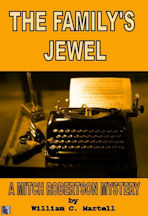
***
MITCH ROBERTSON #2: THE FAMILY'S JEWEL *** - For Kindle!
"The Presidential Suite of the Hollywood Hoover Hotel looked like a bloody battlefield: bodies everywhere, furniture broken, red liquid dripping from the walls, dead soldiers littering the elegant Berber rug as clouds of smoke overhead bounced between two air conditioning vents.
Mitch Robertson stepped over the body of an ex-child star turned sex tape star turned pop star and entered the room, spotted a gun on the floor and picked it up... careful not to spill his coffee with three pumps of mocha syrup from Penny’s Coffee Shop. That coffee was gold, the only thing keeping him going in this dazed state of wakefulness. The gun felt light. Holding it, he saw the silhouette of an 80s action star sitting sideways on a tipped over chair. Motionless. Was he dead? Mitch was still hung over from the Awards Party the night before, and wondered whether this was all some sort of crazy nightmare that he would wake up from... but when he tripped over the brown legs of a bottomless Superhero, flaccid junk encased in a condom but still wearing his mask, and hit the edge of the sofa, gun skittering and coffee spilling, he realized that it was all very real. What the hell had happened here?"
Short Novel. Only 99 cents - and no postage!
IT'S NEW!!
All About Rewrites!
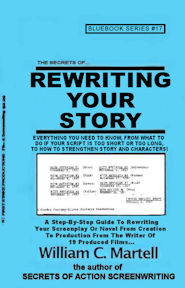
REWRITES Blue Book!
Rewriting In Waves?
When You Finish Your Screenplay Or Novel...
The Rewrites Begin!
The end is just the beginning! You’ve finished your story, but now the rewriting begins! This 405 page book shows you how to rewrite your screenplay or novel to perfection. Everything from Character Consistency to Shoeboxing to How To Give And Receive Notes to 15 Solutions If Your Script’s Too Long! and 15 Solutions If Your Script’s Too Short! to Finding The Cause Of A Story Problem to Good Notes Vs. Bad Notes to Finding Beta Readers to Avoiding Predictability to Learning To Be Objective About Your Work to Script Killer Notes and Notes From Idiots to Production Rewrites and What The Page Colors Mean? and a Complete Rewrite Checklist! The complete book on Rewriting Your Story!
Only: $4.99
HITCHCOCK FOR WRITERS!
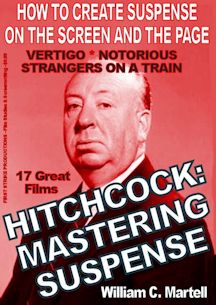
LEARN SUSPENSE FROM THE MASTER!
*** HITCHCOCK: MASTERING SUSPENSE *** - For Kindle!
Alfred Hitchcock, who directed 52 movies, was known as the *Master Of Suspense*; but what exactly is suspense and how can *we* master it? How does suspense work? How can *we* create “Hitchcockian” suspense scenes in our screenplays, novels, stories and films?
This book uses seventeen of Hitchcock’s films to show the difference between suspense and surprise, how to use “focus objects” to create suspense, the 20 iconic suspense scenes and situations, how plot twists work, using secrets for suspense, how to use Dread (the cousin of suspense) in horror stories, and dozens of other amazing storytelling lessons. From classics like “Strangers On A Train” and “The Birds” and “Vertigo” and “To Catch A Thief” to older films from the British period like “The 39 Steps” and “The Man Who Knew Too Much” to his hits from the silent era like “The Lodger” (about Jack The Ripper), we’ll look at all of the techniques to create suspense!
Only $5.99
NO KINDLE REQUIRED! Get the *free* app (any device, except your Mr. Coffee) on the order page on Amazon!
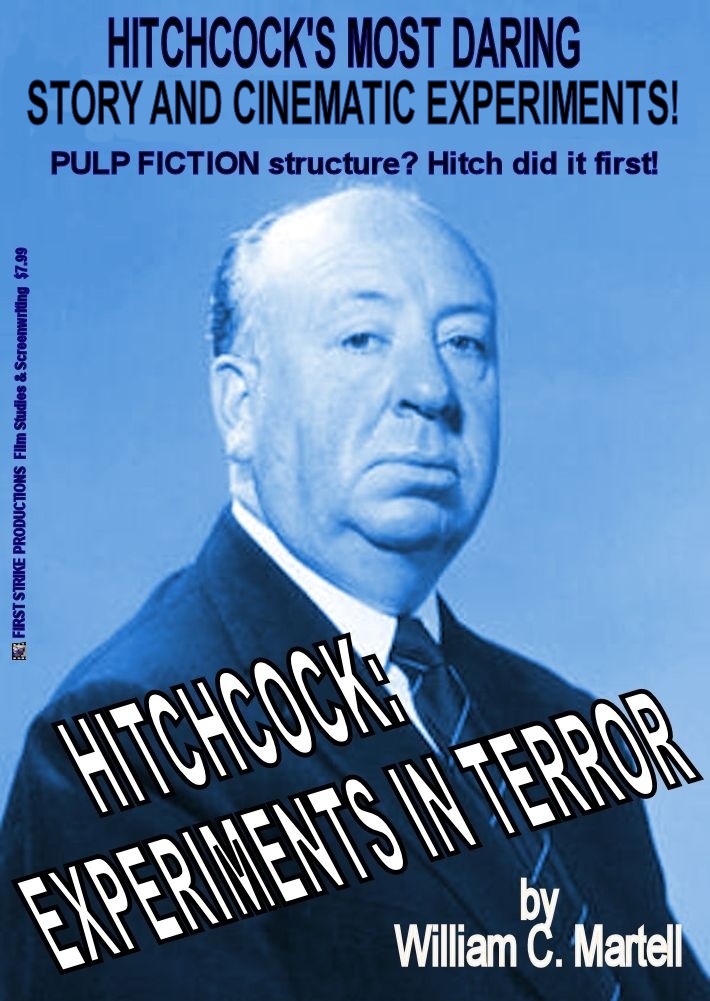
Strange Structures!
*** HITCHCOCK: EXPERIMENTS IN TERROR! *** - For Kindle!
***
Contained Thrillers like "Buried"? Serial Protagonists like "Place Beyond The Pines"? Multiple Connecting Stories like "Pulp Fiction"? Same Story Multiple Times like "Run, Lola, Run"?
HITCHCOCK DID IT FIRST!
This book focuses on 18 of Hitchcock's 52 films with wild cinema and story experiments which paved the way for modern films. Almost one hundred different experiments that you may think are recent cinema or story inventions... but some date back to Hitchcock's *silent* films! We'll examine these experiments and how they work. Great for film makers, screenwriters, film fans, producers and directors.
Only $5.99 - and no postage!
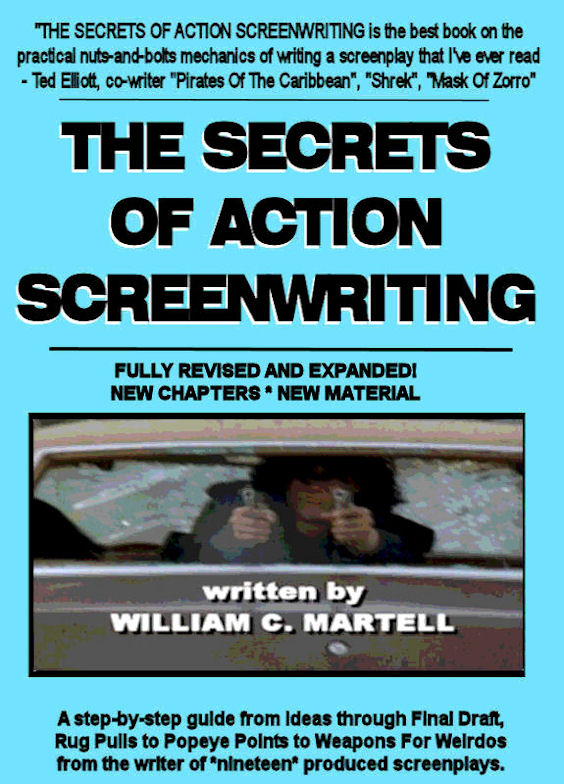
MAKES A GREAT GIFT!
*** THE SECRETS OF ACTION SCREENWRITING *** - For Kindle!
*** THE SECRETS OF ACTION SCREENWRITING *** - For Nook!
Why pay $510 for a used version of the 240 page 2000 version that used to retail for $21.95? (check it out!) when
you can get the NEW EXPANDED VERSION - over 500 pages - for just $9.99? New chapters, New examples, New techniques!
"SECRETS OF ACTION SCREENWRITING is the
best book on the practical nuts-and-bolts mechanics of writing a screenplay I've ever read."
- Ted Elliott, co-writer of MASK OF ZORRO, SHREK, PIRATES OF THE CARIBBEAN and the sequels (with Terry Rossio). (ie; 4 of the top 20 Box Office Hits Of ALL TIME.)
Only $9.99 - and no postage!
Tip FAQ

My New Script Secrets Newsletter!

STORY IN ACTION SERIES!

THE MISSION IMPOSSIBLE MOVIES
NEW: Updates On Films 7 & 8 Casting!
All Six Movies analyzed! All of the mission tapes, all of the “that’s impossible!” set pieces and stunts, the cons and capers - and how these scenes work, the twists and double crosses, the tension and suspense (and how to generate it), the concept of each film as a stand alone with a different director calling the shots (broken in the sixth film), the gadgets, the masks, the stories, the co-stars and team members (one team member has been in every film), the stunts Tom Cruise actually did (and the ones he didn’t), and so much more! Over 120,000 words of fun info!
THE MISSION IMPOSSIBLE MOVIES - 347 Pages - Only $3.99 !

BRAND NEW!
*** THE BOURNE MOVIES
NEW: Updates on TREADSTONE TV show!
All five "Bourne" movies (including "Legacy" and it's potential sequels) - what are the techniques used to keep the characters and scenes exciting and involving? Reinventing the thriller genre...
or following the "formula"? Five films - each with an interesting experiment! A detailed analysis of each
of the films, the way these thrillers work... as well as a complete list of box office and critical
statistics for each film. This book is great for writers, directors, and just fans of the series.
Only $3.99 - and no postage!
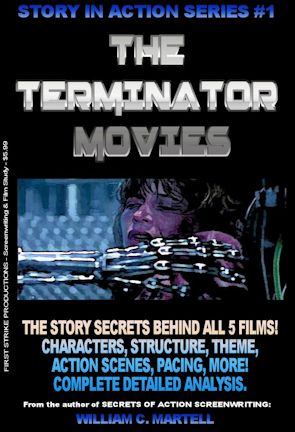
Over 240 pages!
*** THE TERMINATOR MOVIES *** - For Kindle!
He's back! The release of "Terminator: Dark Fate" is set to begin a new trilogy in
the Terminator story... 35 years after the first film was released. What draws us to these films about
a cybernetic organism from the future sent back in time? Why is there a new proposed trilogy every few
years? This book looks at all five Terminator movies from a story standpoint - what makes them work
(or not)? What are the techniques used to keep the characters and scenes exciting and involving? How
about those secret story details you may not have noticed? Containing a detailed analysis of each of
the five films so far, this book delves into the way these stories work... as well as a complete list of
box office and critical statistics for each film. This book is great for writers, directors, and just
fans of the series.
ONLY $3.99 - and no postage!
NO KINDLE REQUIRED! Get the *free* app (any device, except your Mr. Coffee) on the order page on Amazon!

NEW BUT OLD!
*** VINTAGE #1: HOW TO WRITE PHOTOPLAYS *** - For Kindle!
***
Screenwriting books have been around as long as films have. This series reprints vintage screenwriting books with a new introduction and history, plus new articles which look at how these lessons from almost 100 years ago apply to today’s screenplays. Anita Loos book is filled with information which still applies.
In addition to the full text of the original book, you get the full screenplay to Miss Loos' hit THE LOVE EXPERT, plus several new articles on the time period and women in Hollywood.
Only $2.99 - and no postage!
THE BLUE BOOKS!
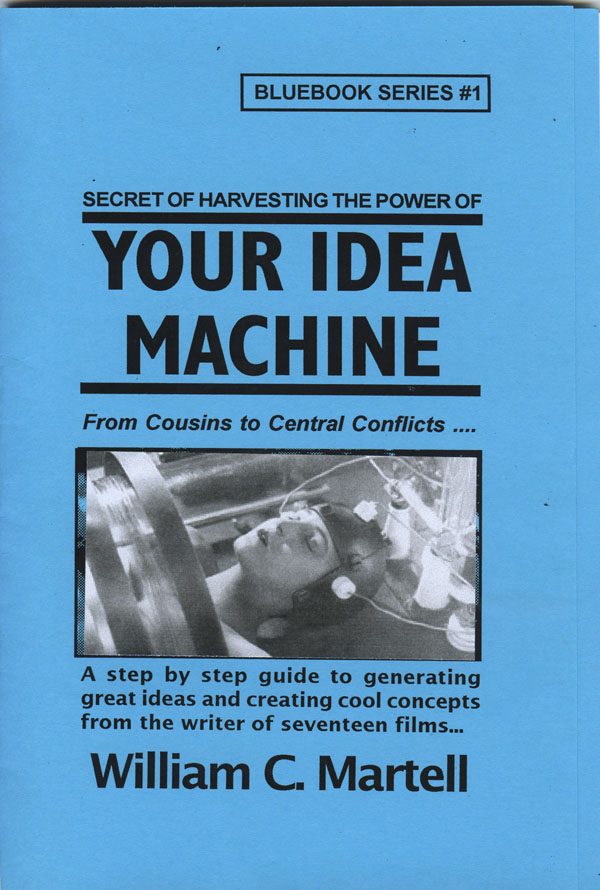
FIND A GREAT IDEA!
*** YOUR IDEA MACHINE *** - For Kindle!
****
Expanded version with more ways to find great ideas! Your screenplay is going to begin with an idea. There are good ideas and bad ideas and commercial ideas and personal ideas. But where do you find ideas in the first place? This handbook explores different methods for finding or generating ideas, and combining those ideas into concepts that sell. The Idea Bank, Fifteen Places To Find Ideas, Good Ideas And Bad Ideas, Ideas From Locations And Elements, Keeping Track Of Your Ideas, Idea Theft - What Can You Do? Weird Ways To Connect Ideas, Combing Ideas To Create Concepts, High Concepts - What Are They? Creating The Killer Concept, Substitution - Lion Tamers & Hitmen, Creating Blockbuster Concepts, Magnification And The Matrix, Conflict Within Concept, Concepts With Visual Conflict, Avoiding Episodic Concepts, much more! Print version is 48 pages, Kindle version is over 175 pages!
Only $4.99 - and no postage!
FIGURE OUT YOUR STORY!
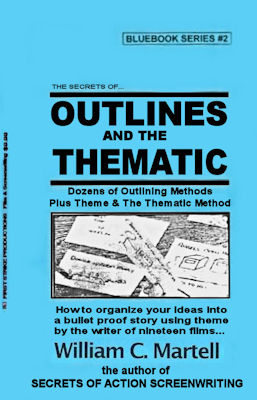
OUTLINES & THE THEMATIC Blue Book.
ARE YOUR SCENES IN THE RIGHT ORDER?
AND ARE THEY THE RIGHT SCENES?
Your story is like a road trip... but where are you going? What's the best route to get there? What are the best sights to see along the way? Just as you plan a vacation instead of just jump in the car and start driving, it's a good idea to plan your story. An artist does sketches before breaking out the oils, so why shouldn't a writer do the same? This Blue Book looks at various outlining methods used by professional screenwriters like Wesley Strick, Paul Schrader, John August, and others... as well as a guest chapter on novel outlines. Plus a whole section on the Thematic Method of generating scenes and characters and other elements that will be part of your outline. The three stages of writing are: Pre-writing, Writing, and Rewriting... this book looks at that first stage and how to use it to improve your screenplays and novels.
Only $4.99 - and no postage!
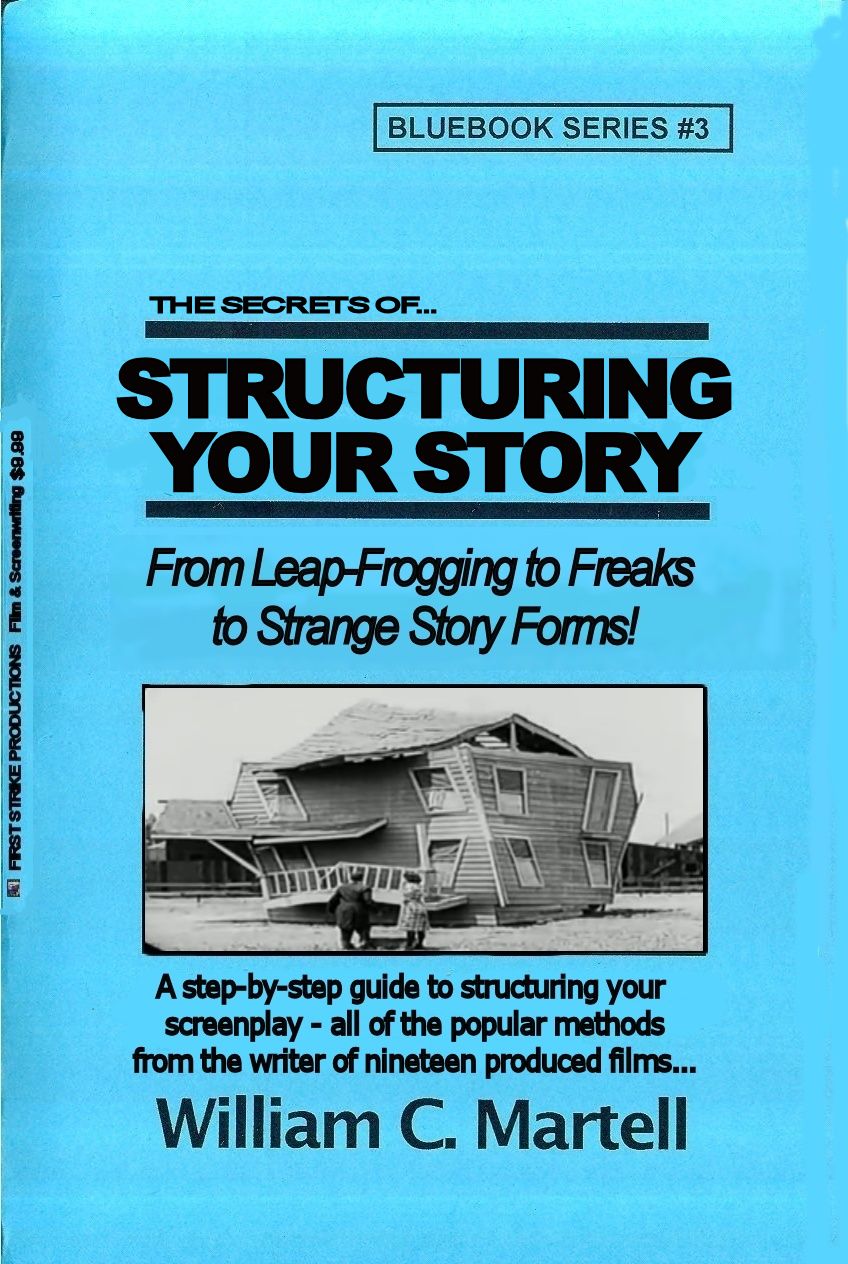
GOT STRUCTURE?!
*** STRUCTURING YOUR STORY *** - For Kindle!
William Goldman says the most important single element of any screenplay is structure. It’s the skeleton under the flesh and blood of your story. Without it, you have a spineless, formless, mess... a slug! How do you make sure your structure is strong enough to support your story? How do you prevent your story from becoming a slug? This Blue Book explores different types of popular structures from the basic three act structure to more obscure methods like leap-frogging. We also look at structure as a verb as well as a noun, and techniques for structuring your story for maximum emotional impact. Most of the other books just look at *structure* and ignore the art of *structuring* your story. Techniques to make your story a page turner... instead of a slug!
Only $4.99 - and no postage!
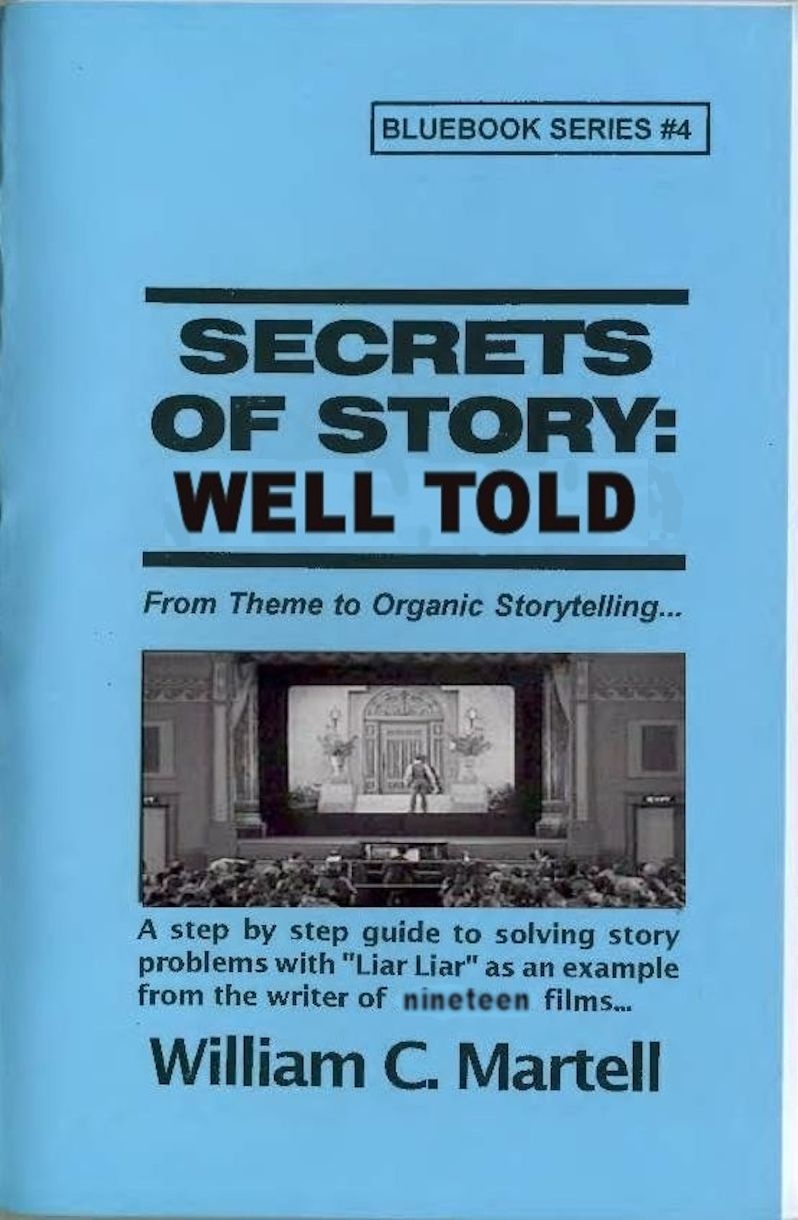
STORY: WELL TOLD!
*** STORY: WELL TOLD *** - For Kindle!
This book takes you step-by-step through the construction of a story... and how to tell a story well, why Story always starts with character... but ISN'T character, Breaking Your Story, Irony, Planting Information, Evolving Story, Leaving No Dramatic Stone Unturned, The Three Greek Unities, The Importance Of Stakes, The Thematic Method, and how to create personal stories with blockbuster potential. Ready to tell a story?
Print version was 48 pages, Kindle version is over 85,000 words - 251 pages!
Only $4.99 - and no postage!

START STRONG!
*** HOOK 'EM IN TEN *** - For Kindle!
Your story doesn't get a second chance to make a great first impression, and this book shows you a
bunch of techniques on how to do that. From the 12 Basic Ways To Begin Your Story, to the 3 Stars Of
Your First Scene (at least one must be present) to World Building, Title Crawls, Backstory, Starting
Late, Teasers and Pre Title Sequences, Establishing Theme & Motifs (using GODFATHER PART 2), Five Critical
Elements, Setting Up The Rest Of The Story (with GODFATHER), and much more! With hundreds of examples
ranging from Oscar winners to classic films like CASABLANCA to some of my produced films (because
I know exactly why I wrote the scripts that way). Biggest Blue Book yet!
Print version was 48 pages, Kindle version is over 100,000 words - 312 pages!
Only $4.99 - and no postage!
NO KINDLE REQUIRED! Get the *free* app (any device, except your Mr. Coffee) on the order page on Amazon!
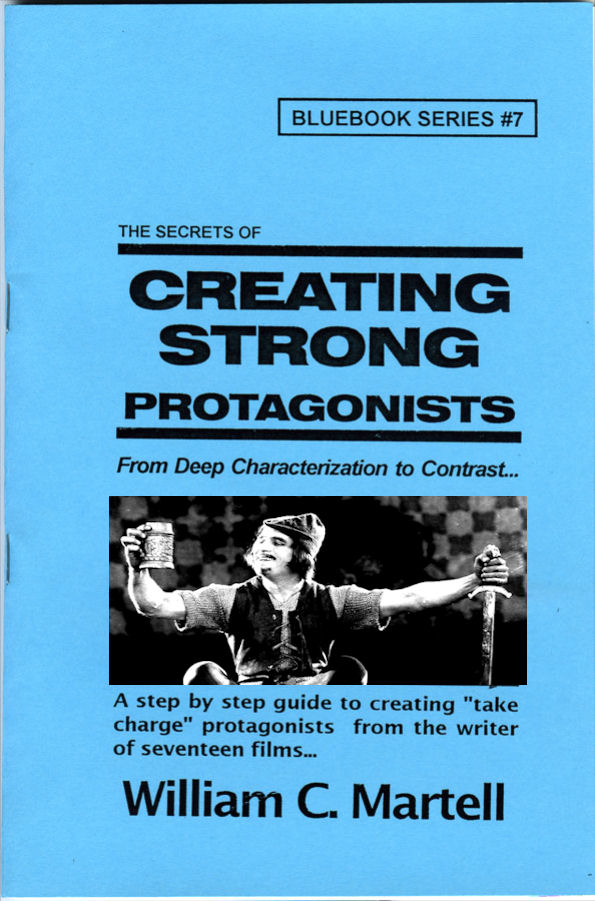
MOVIES ARE CHARACTERS!
*** CREATING STRONG PROTAGONISTS *** - For Kindle!
*** CREATING STRONG PROTAGONISTS *** - For Nook!
Expanded version with more ways to create interesting protagonists! A step-by-step guide to creating "take charge" protagonists. Screenplays are about characters in conflict... characters in emotional turmoil... Strong three dimensional protagonists who can find solutions to their problems in 110 pages. But how do you create characters like this? How do you turn words into flesh and blood? Character issues, Knowing Who Is The Boss, Tapping into YOUR fears, The Naked Character, Pulp Friction, Man With A Plan, Character Arcs, Avoiding Cliche People, Deep Characterization, Problem Protagonists, 12 Ways To Create Likable Protagonists (even if they are criminals), Active vs. Reactive, The Third Dimension In Character, Relationships, Ensemble Scripts, and much, much more. Print version is 48 pages, Kindle version is once again around 205 pages!
ONLY $4.99 - and no postage!
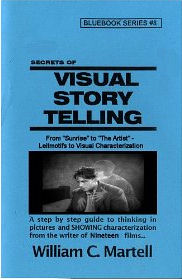
I WRITE PICTURES!
*** VISUAL STORYTELLING *** - For Kindle! (exclusive)
Show Don't Tell - but *how* do you do that? Here are techniques to tell stories visually! Using Oscar Winning Films and Oscar Nominated Films as our primary examples: from the first Best Picture Winner "Sunrise" (1927) to the Oscar Nominated "The Artist" (which takes place in 1927) with stops along the way Pixar's "Up" and Best Original Screenplay Winner "Breaking Away" (a small indie style drama - told visually) as well as "Witness" and other Oscar Winners as examples... plus RISE OF THE PLANET OF THE APES. Print version is 48 pages, Kindle version is over 200 pages!
ONLY $4.99 - and no postage!
DESCRIPTION & VOICE Blue Book!
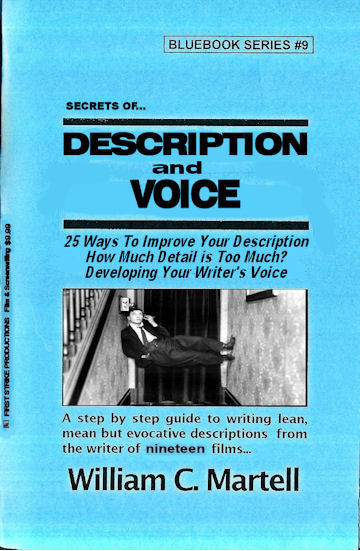
DESCRIPTION & VOICE Blue Book.
IS HALF OF YOUR STORY IN TROUBLE?
Most screenplays are about a 50/50 split between dialogue and description - which means your description is just as important as your dialogue. It just gets less press because the audience never sees it, the same reason why screenwriters get less press than movie stars. But your story will never get to the audience until readers and development executives read your script... so it is a very important factor. Until the movie is made the screenplay is the movie and must be just as exciting as the movie. So how do you make your screenplay exciting to read? Description is important in a novel as well, and the “audience” does read it... how do we write riveting description?
Only $4.99 and no postage!

PRO DIALOGUE TECHNIQUES!
*** DIALOGUE SECRETS *** - For Kindle!
***
Expanded version with more ways to create interesting dialogue! How to remove bad dialogue (and what *is* bad dialogue), First Hand Dialogue, Awful Exposition, Realism, 50 Professional Dialogue Techniques you can use *today*, Subtext, Subtitles, Humor, Sizzling Banter, *Anti-Dialogue*, Speeches, and more. Tools you can use to make your dialogue sizzle! Special sections that use dialogue examples from movies as diverse as "Bringing Up Baby", "Psycho", "Double Indemnity", "Notorious", the Oscar nominated "You Can Count On Me", "His Girl Friday", and many more! Print version is 48 pages, Kindle version is over 175 pages!
Only $4.99 - and no postage!

WHAT IS A SCENE?
*** SCENE SECRETS *** - For Kindle!
***
What is a scene and how many you will need? The difference between scenes and sluglines. Put your scenes on trial for their lives! Using "Jaws" we'll look at beats within a scene. Scene DNA. Creating set pieces and high concept scenes. A famous director talks about creating memorable scenes. 12 ways to create new scenes. Creating unexpected scenes. Use dramatic tension to supercharge your scenes. Plants and payoffs in scenes. Plus transitions and buttons and the all important "flow"... and more! Over 65,000 words! Print version was 48 pages, Kindle version is around 210 pages!
Only $4.99 - and no postage!
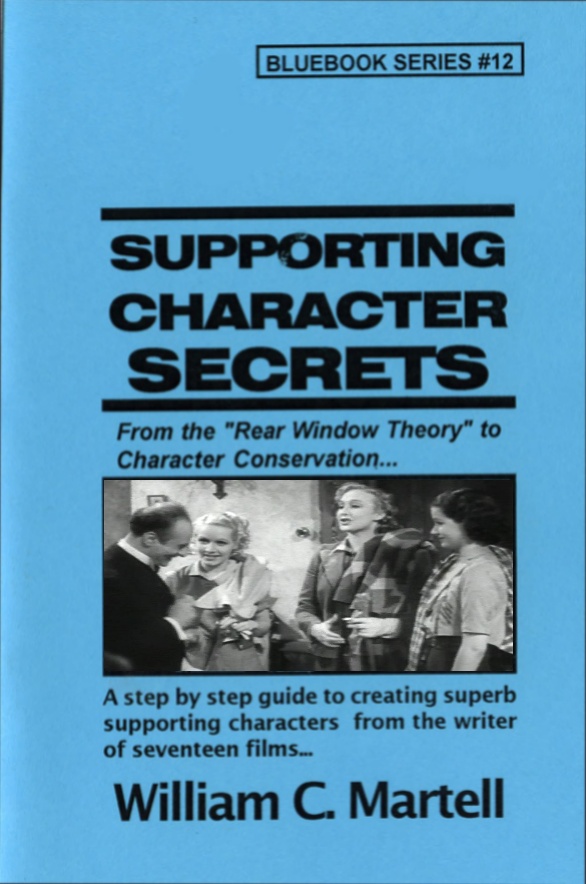
SUBPLOTS?
*** SUPPORTING CHARACTER SECRETS *** - For Kindle! (Exclusive)
Expanded version with more techniques to flesh out your Supporting Characters and make them individuals. Using the hit movie BRIDESMAIDS as well as other comedies like THE HANGOVER and TED and HIGH FIDELITY and
40 YEAR OLD VIRGIN and many other examples we look at ways to make your Supporting Characters come alive on the page.
Print version was 48 pages, Kindle version is around 170 pages!
ONLY $4.99 - and no postage!
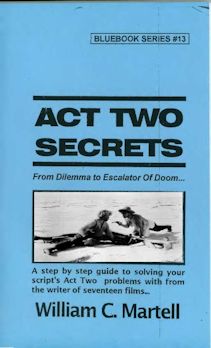
ACT TWO SOLUTIONS!
*** ACT TWO SECRETS *** - For Kindle!
Expanded version with more techniques to help you through the desert of Act Two! Subjects Include: What Is Act Two? Inside Moves, The 2 Ps: Purpose & Pacing, The 4Ds: Dilemma, Denial, Drama and Decision, Momentum, the Two Act Twos, Subplot Prisms, Deadlines, Drive, Levels Of Conflict, Escalation, When Act Two Begins and When Act Two Ends, Scene Order, Bite Sized Pieces, Common Act Two Issues, Plot Devices For Act Two, and dozens of others. Over 67,000 words (that’s well over 200 pages) of tools and techniques to get you through the desert of Act Two alive!
Print version was 48 pages, Kindle version is well over 200 pages!
ONLY $4.99 - and no postage!
All About Endings!
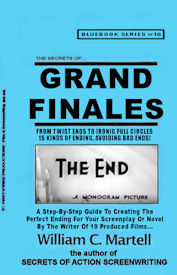
GRAND FINALES Blue Book!
The Perfect Ending For Your Story!
The First Ten Pages Of Your Screenplay Are Critical,
But What About The Last 10 Pages?
Creating the perfect ending to your story! This 100,000 word book shows you how to end your story with a bang, rather than a whimper. Everything from Resolution Order to Act Three Tools to Happy or Sad Endings? to How The Beginning Of Your Story Has Clues To The Ending (in case you were having trouble figuring out how the story should end) to Falling Action to How To Avoid Bad Endings to Writing The Perfect Twist Ending to Setting Up Sequels & Series to Emotional Resolutions to How To Write Post Credit Sequences to Avoiding Deus Ex Machinas, to 20 Different Types Of Ends (and how to write them) and much more! Everything about endings for your screenplay or novel!
Only: $4.99
NO KINDLE REQUIRED! Get the *free* app (any device, except your Mr. Coffee) on the order page on Amazon!
All About LOGLINES, TREATMENTS, and PITCHING!

LOGLINES, TREATMENTS, and PITCHING! Blue Book!
Distilling Your Screenplay!
Loglines, Treatments, Pitching, Look Books, Pitch Decks, One Pagers, Rip-O-Matics?
You have written a brilliant 110 page screenplay, but how do you get anyone to read it? You need to distill it down into some form of verbal moonshine or story rocket fuel that will ignite that bored development executive or manager or agent and get them to request your screenplay. But how do you shrink those 110 pages into a 25 word logline or a 2 minute elevator pitch or a one page synopsis or a short paragraph? This 100,000 word book shows you how! Everything you need to know! From common logline mistakes (and how to solve them) to how your pitch can reveal story problems to the 4 types of pitches!
272 Pages - ONLY $4.99!
READY TO BREAK IN?
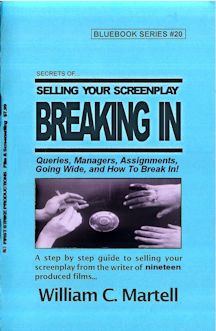
THE BUISINESS SIDE
*** BREAKING IN BLUE BOOK *** - For Kindle!
Should really be called the BUSINESS BLUE BOOK because it covers almost everything you will need to
know for your screenwriting career: from thinking like a producer and learning to speak their language,
to query letters and finding a manager or agent, to making connections (at home and in Hollywood) and
networking, to the different kinds of meetings you are will have at Studios, to the difference between
a producer and a studio, to landing an assignment at that meeting and what is required of you when you
are working under contract, to contracts and options and lawyers and... when to run from a deal!
Information you can use *now* to move your career forward! It's all here in the Biggest Blue Book yet!
Print version was 48 pages, Kindle version is over 400 pages!
$4.99 - and no postage!

Use your creative energy to focus on the content; let Final Draft take care of the style. Final Draft is the number-one selling application specifically designed for writing movie scripts, television episodics and stage plays. Its ease-of-use and time-saving features have attracted writers for almost two decades positioning Final Draft as the Professional Screenwriters Choice. Final Draft power users include Academy, Emmy and BAFTA award winning writers like Oliver Stone, Tom Hanks, Alan Ball, J.J. Abrams, James Cameron and more.
* * * Buy It!
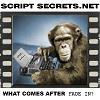
|

